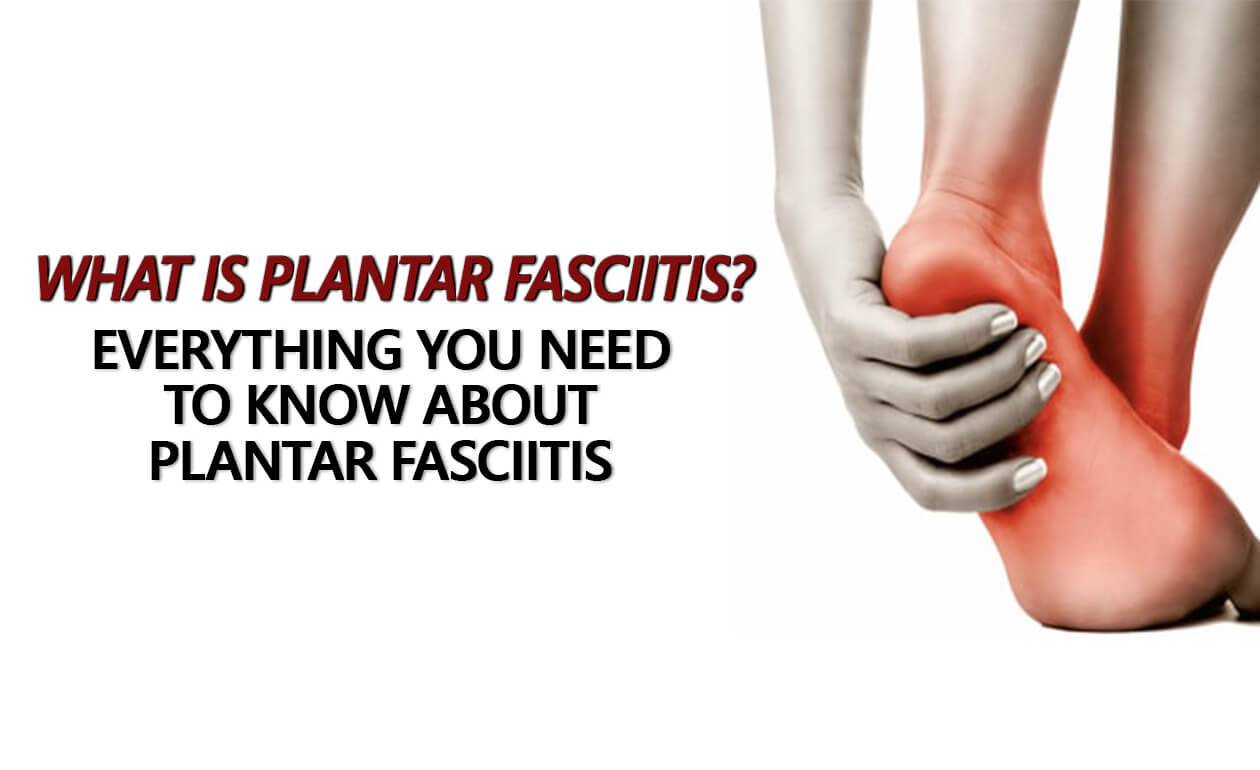What is Plantar Fasciitis? How do you know you have plantar fasciitis?
Most people are not familiar with plantar fasciitis until they experience heel pain or are diagnosed with this foot condition. You may first experience plantar fasciitis pain as soon as you stand up in the morning or after a long resting period. You may describe this unpleasant pain as dull, while others experience a sharp or burning pain. If you are wondering what is plantar fasciitis, keep reading. We find great alternatives to eliminating or minimizing your pain.
What is plantar fasciitis?
Plantar fasciitis is the most common cause of arch and heel pain. It occurs when the plantar fascia (the web-like ligament that connects your heel to the front of your foot) becomes inflamed and is stretched out.
 Arch Pain
Arch Pain
Arch pain caused by plantar fasciitis can range from mild to severe. Arch pain is usually experienced at the bottom of the foot at any point between the heel and the ball of the foot. Most arch pain is due to strain or inflammation of the plantar fascia.
Heel Pain
Heel pain is a common foot problem that is often caused by a couple of foot conditions: plantar fasciitis or Achilles tendonitis. Most commonly, heel pain is usually experienced at the bottom of the heel (plantar fasciitis) or just behind it (Achilles tendinitis), where the Achilles tendon connects to the heel bone. Heel pain may be so severe that just standing up first thing in the morning can be unbearable.
What are the common symptoms of plantar fasciitis?
The most common symptom of plantar fasciitis is a stabbing pain at the bottom of the foot, which can gradually develop over time. However, not everyone develops plantar fasciitis at the same rate or experiences the same pain. Although symptoms may vary from one person to another, common symptoms remain the same.
- Pain and stiffness.
- Tender touch to heel.
- Stabbing pain and/or burning to the bottom of the foot near the heel.
What are common causes of plantar fasciitis?

Plantar fasciitis can occur at any age since the plantar fascia undergoes immense wear and tear during an entire lifetime. Runners, nurses, teachers, restaurant workers, pregnant women, and anyone else who wears shoes without adequate support are most like to develop plantar fasciitis. Consequently, repetitive motion from running and walking or added pressure from weight gain can damage or tear the plantar fascia; causing inflammation and pain. Most common causes of plantar fasciitis are:
- Excessive pronation.
- High arches or flat feet.
- Wearing worn out shoes.
- Standing or walking in heels or dress shoes.
- Walking, standing, or running for long periods of time without adequate support.
- Exercising on a hard surface – for example, running on a road instead of a track.
- Being overweight – this will put extra strain on the heels.
- Wearing shoes that do not fit well.
- Wearing shoes with poor cushioning or poor arch support.
When is plantar fasciitis most common?
Plantar fasciitis is most common in spring and summer because many people tend to wear unsupportive shoes such as flimsy flip-flops and others increase their daily activities. In addition, we also tend to see additional cases of plantar fasciitis after the holiday season.
Unsupportive summer footwear
As soon as the weather warms up, most people trade their supportive sneakers for summer flimsy footwear with little to no support. Consequently, shoes with no arch support can overstretch, tear, or inflame the plantar fascia.
Physical activity increase
People tend to be more active in spring and summer and many tend to increase their walking. Perhaps, increase their physical activity by beginning a new running plan or picking up a fitness class. While physical activity is great for one’s health, these new activities require a lot more standing or walking which places repeated stress on the heels. In fact, repetitive motion can damage or tear the plantar fascia; causing inflammation and pain.
Holiday Weight Gain
We also tend to see additional cases of plantar fasciitis after the holiday season since many people tend to gain weight over a short period of time. So much that, the additional weight increases pressure on the plantar fascia; thus causing your foot pain.
Treatment options for plantar fasciitis
Dealing with Plantar Fasciitis can be difficult. However, there’re treatment options to reduce or in some cases eliminate foot pain. Such treatment options include arch supports, supportive shoes, compression socks, compression gel bandages, foot splints, foot massage balls, stretching exercises, and anti-inflammatories.
1. Arch Supports
One of the best options to reduce foot pain is by wearing a good arch support so the foot stays supported. Most over-the-counter and custom arch supports help combat over-pronation and promote better posture while standing, walking, and running. They help realign the body and evenly distribute body weight.
 Superfeet Green
Superfeet Green
The Superfeet Green is a firm, heavy-duty shock absorbing insole with great support. Many customers with high arches prefer the Green arch support for the best hold on their arch when walking or running. This Superfeet Green arch support has a hard plastic bottom that takes some time getting used to, but it’s an excellent shock absorber.
Superfeet Blue
Compared to the Superfeet Green, the Superfeet Blue is a thinner, high-performance foam insole that helps support and cushions the foot for long-lasting comfort. This Blue insole is thin enough to help improve the fit of a wide range of footwear. Most people with low to medium arches have experienced the best results with the Superfeet Blue.
Although they have distinct features, both are high-density closed-cell foam insoles that support and cushion the heel and foot. Both Superfeet insoles have stabilizer heel cups that help keep the heel in place and help reduce heel movement which helps keeps the plantar fasciia from stretching.

Aetrex Lynco L2200 Series
As for Aetrex, the Lynco L2220 is the most popular arch support. They are exceptional for their slow recovery memory foam, which customizes to the shape of the foot. The arch support’s memory foam customizes to the foot, providing both balance and body alignment, thus reducing unnecessary stress on the plantar fascia. While the memory foam is a great option, they could be difficult to fit since they may only fit in shoes with thick removable insoles. For this reason, wider athletic shoes or shoes designed to accommodate orthotics will work best with this model. In addition, this L2200 arch support is offered with and without a metatarsal pad.
Aetrex Lynco L2400 Series
When the L2200 is too thick for the customer and would like a more customized arch support, the L2400 arch support is a better option. This model is a little thinner than the memory foam L2200 so it will be easier to fit into shoes with regular removable insoles. In addition, the L2400 series is a customizable over-the-counter arch support designed with removable gel plugs. Since the right and left foot are not mirror images, these L2400 arch supports allow customers to modify for differences in their feet. They help relieve pressure points and create a pressure-free environment in specific areas.
Lucky Feet Shoes Dress Arch Supports
 Lucky Feet Shoes Dress Arch Supports are designed to support the arches and evenly distribute pressure across the whole foot. Their built-in arch support increases stability and reduces excessive motion; preventing the feet from flattening out and limiting pronation. In addition, these arch supports are designed with comfort in mind and are thinner than most. Their ¾ length is ideal for those looking for a shorter length arch support. They are great for a wide range of shoes including athletic, casual and most dress shoes. Plus, they are a good alternative for active individuals who are looking for more support and less conformity in their orthotics.
Lucky Feet Shoes Dress Arch Supports are designed to support the arches and evenly distribute pressure across the whole foot. Their built-in arch support increases stability and reduces excessive motion; preventing the feet from flattening out and limiting pronation. In addition, these arch supports are designed with comfort in mind and are thinner than most. Their ¾ length is ideal for those looking for a shorter length arch support. They are great for a wide range of shoes including athletic, casual and most dress shoes. Plus, they are a good alternative for active individuals who are looking for more support and less conformity in their orthotics.
2. Supportive shoes
Wearing shoes with arch support is considered one of the most effective ways to reduce foot pain associated with plantar fasciitis. Some of the best shoes for heel pain will align the feet to their natural position and evenly distribute weight across the feet. They will control ankle and heel movement reducing the pulling of the plantar fascia which is a primary cause of heel pain.
Good Arch Support
Ideal plantar fasciitis shoes should keep one supported all day. They should offer good arch support to keep the feet from flattening out and while controlling pronation.
Contoured Footbeds
Contoured footbeds help promote alignment by evenly distributing weight across the feet.
Stable Heel Cups
Stable deep heel cups keep heels padded while keeping one stabilized with every step.
Or Removable Footbeds
For those customers who require additional support, shoes with removable footbeds are great since they accommodate most custom and over-the-counter orthotics
3. Compression Socks/Sleeves
Compression socks and sleeves are often worn by athletes to recover faster, reduce swelling, and alleviate the pain from common injuries such as plantar fasciitis and Achilles tendonitis. They also help improve blood flow.
OrthoSleeve Compression Sleeve (FS6)
The OrthoSleeve Compression Foot Sleeve (FS6) features Compression Zone Technology that provides six zones of support to help reduce foot pain, heel pain and arch pain by lifting, stretching, and stabilizing the plantar fascia. They help relieve plantar fasciitis pain, ease foot pain and swelling while improving blood circulation.
OrthoSleeve Compression Sleeve Features & Benefits
- Lifts, stretches, and stabilizes the plantar fascia.
- Eases foot, heel, and arch pain.
- Graduated compression improves circulation to reduce swelling and aid recovery.
- Features 20-30 mmHG of compression above and below the heel.
- iWick fibers wick moisture to keep feet cool and dry.
- Offered in three compression levels: firm, moderate, and light.
- Wear while sleeping to reduce most heel pain.
- Medical grade support designed for all-day comfort.
- Easy-on and easy-off.
- Day or night use.
Feetures Plantar Fasciitis Relief Sock

Feetures Plantar Fasciitis Relief Socks provide support and relieve heel pain by lifting, stretching, and stabilizing the plantar fascia. Its patented Targeted Compression enhances fit and feel to provide support and relief for plantar fasciitis.
Feetures Plantar Fasciitis Relief Sock Features & Benefits
- Eases heel and arch pain caused by plantar fasciitis.
- Quarter Crew Height easily slips on and off.
- Easy to wear socks provide convenient relief.
- Targeted Compression lifts, stretches, and stabilizes the plantar fascia and supports the Achilles tendon.
- iWick fibers wick moisture.
- 88% iWick Nylon, 12% Lycra Spandex.
4. Compression Gel Bandage
Compression gel bandages assist in the prevention, management, and recovery from muscle pain, swelling, and inflammation. They provide cooling and compression therapy in one simple step, helping recover from muscle sprains and strains faster and more effectively.
CoolXChange Compression Cooling Gel Bandage
CoolXChange Cooling gel bandage is both a compression and cooling gel bandage that helps manage pain and inflammation. It provides cooling and compression therapy in one simple step faster and much more effectively. By combining cooling and compression, the elastic compression reduces the amount of blood flow and heat in the injured area, which minimizes pain and swelling. This gel bandage works instantly and can be worn continuously for extended periods of time, without causing ice burns, unlike traditional cooling methods. In addition, the CoolXChange advances R.I.C.E. (Rest, Ice, Compression and Elevate) method which is widely regarded as one of the best ways to reduce pain caused by plantar fasciitis.
CoolXChange Compression Cooling Gel Bandage Features & Benefits
- Assists in the prevention, management, and recovery from muscle pain, swelling, and inflammation.
- Provides cooling and compression therapy in one simple step, helping you recover from muscle sprains and strains faster and more effectively.
- Ready to Use – No refrigeration needed.
- Provides immediate and continuous cooling for up to 2 hours.
- Self-adhesive.
- No mess, no smell.
5. Night Splints
Night splints are designed to relieve pain and discomfort from plantar fasciitis and Achilles tendonitis. They have a semi-rigid strap that pulls the toes and foot upwards into a slight dorsiflexion position.
 Night Splint
Night Splint
The Thermoskin Night Splint provides relief during the night from the pain and discomfort of plantar fasciitis and Achilles tendonitis. This night splint is designed to be worn during sleep or rest to help relieve pain from plantar fasciitis and Achilles tendonitis. It may also be worn during the day to provide longer per day treatment times. In addition, it’s made with 3-dimensional linings that provide insulation and wick away moisture via air circulation. This allows the skin to remain well oxygenated and comfortable for extended periods.
Thermoskin Night Splint Features & Benefits
- Holds the foot in a gentle dorsiflexion.
- Thermal properties help reduce inflammation.
- Promotion of increased blood flow facilitates enhanced recovery
- Non-slip Safety Sole rubber grip bottom helps prevent slipping.
- Provides light but firm compression to counteract tissue swelling.
- Clinically tested to increase the skin and muscle temperature.
- Increases elasticity and reactivity of the muscle.
- Made in the U.S. with the high-quality standards.
- Fits either right or left foot.
6. Foot Massage Ball
A foot massage ball can massage away plantar fasciitis pain. A foot massage lengthens and stretches the plantar fascia ligament, providing immediate relief. Plus, a massage ball allows for pain relief to be within reach everywhere the customer goes!
Due North Foot Rubz
Foot Rubz Hand and Foot massage ball uses ancient Asian acupressure techniques to apply pressure to relax muscles, reduce tension and increase circulation. This Foot Rubz provides soothing relief for sore muscles and stimulates circulation. In addition, it helps relieve knots and tightness around the plantar fascia ligament and stimulates blood flow to affected areas for long-term healing.
Due North Foot Rubz Features & Benefits
- 160 nubs provide soothing stimulation that will immediately begin to relax and eliminate tension: Makes feet, hands, and any sore or tired muscles feel great in minutes.
- Control the depth of the massage with applied pressure to ensure the utmost relief of muscle soreness.
- Great aid in the treatment of Plantar Fasciitis
7. RICE Method
One of the best plantar fasciitis treatments is a method called RICE which is an acronym. The “R” stands for Rest, “I” is for Ice, “C” is for Compression and “E” stands for Elevate.
 REST
REST
Staying off the feet as much as possible will keep the tissue bands underneath the foot from irritation. This means taking a break from any activity that may be causing the pain or soreness.
ICE
Cold will reduce pain and swelling. Have your customer apply an ice or cold pack right away to prevent or minimize swelling. They should apply the ice or cold pack for 10 to 20 minutes, 3 or more times a day. In addition, a frozen water bottle also works. Ask your customer to roll their feet on a frozen water bottle which massages the tissue bands to reduce inflammation.
Compression
Compression, or wrapping the injured or sore area with an elastic bandage (such as CoolXchange), will help decrease swelling. Advise your customers not to wrap it too tightly, because this can cause more swelling below the affected area. Have them loosen the bandage if it gets too tight. Signs that the bandage is too tight include numbness, tingling, increased pain, coolness, or swelling in the area below the bandage.
Elevate
Advise your customers to elevate the injured or sore area on pillows while applying ice and anytime they are sitting or lying down. They should try to keep the area at or above the level of their heart to help minimize swelling.
8. Stretching Exercises
Stretching exercise help relieve plantar fascia pain. This means stretching the plantar fascia so it does not put additional strain on the insertion to the heel. It is always to best to perform stretching exercises before getting out of bed.
Stretch your calves
- Stand arm’s length from a wall and lean forward against the wall with one knee straight and heel on the ground.
- Hold the stretch for 15 to 30 seconds and release. Repeat three times.
- Reverse the position of your legs and repeat.
Stretch your heel cords and foot arches
- Find a strong and sturdy table. Lean forward onto the countertop, spreading your feet apart with one foot in front of the other.
- Bend your knees and squat down, keeping your heels on the ground as long as possible.
- Hold for 15 seconds, relax and straighten up. Repeat three times.
Stretch your plantar fascia #1
- While seated, roll your foot back and forth over a round or cylindered shaped object, such as ice-cold can. Repeat for one minute and then switch to the other foot.
- Next, cross one leg over the other for the big toe stretch. Grab your big toe, pull it gently toward you, and hold for 15 to 30 seconds. Repeat three times, then reverse and do the same with the other foot.
Stretch your plantar fascia #2
- Fold a towel lengthwise to make an exercise strap.
- Sit down, and place the folded towel under the arches of both feet.
- Grab the ends of the towel with both hands, and gently pull the tops of your feet toward you. Hold for 15 to 30 seconds, and repeat three times.
Where to shop the best footwear for Plantar Fasciitis?
Come into any of our and try footwear for plantar fasciitis! At Lucky Feet Shoes, we carry many shoe insoles, over-the-counter arch supports, and shoes for plantar fasciitis. If you are looking for footwear for plantar fasciitis in Orange County, the Inland Empire, Los Angeles County, Temecula or Riverside; we have nine comfort shoe stores to serve you! Come and visit us today! Therefore, we invite you to stop by for a FREE FOOT ANALYSIS and try on our best shoes for plantar fasciitis. We carry many comfortable plantar fasciitis sandals, shoes, heels, walking shoes, running shoes, casual sneakers, clogs, wedges, flats, booties, and boots. Don’t let plantar fasciitis keep you from enjoying you the warm weather! Schedule a free foot analysis today!

Jerick Sobie
Since 2005, I have been a dedicated small business owner specializing in footwear retail. With over 20 years of experience, my business partner and I have helped customers find the perfect shoes that combine style, comfort, and quality. Our expertise extends beyond local sourcing—we have traveled internationally to discover high-quality footwear that meets our customers’ needs. In addition to running my business, I have participated in numerous health fairs and educational seminars, sharing my knowledge on proper footwear and foot health. Committed to providing exceptional service, We carefully curate our selections to ensure the best fit and support for every customer.

























